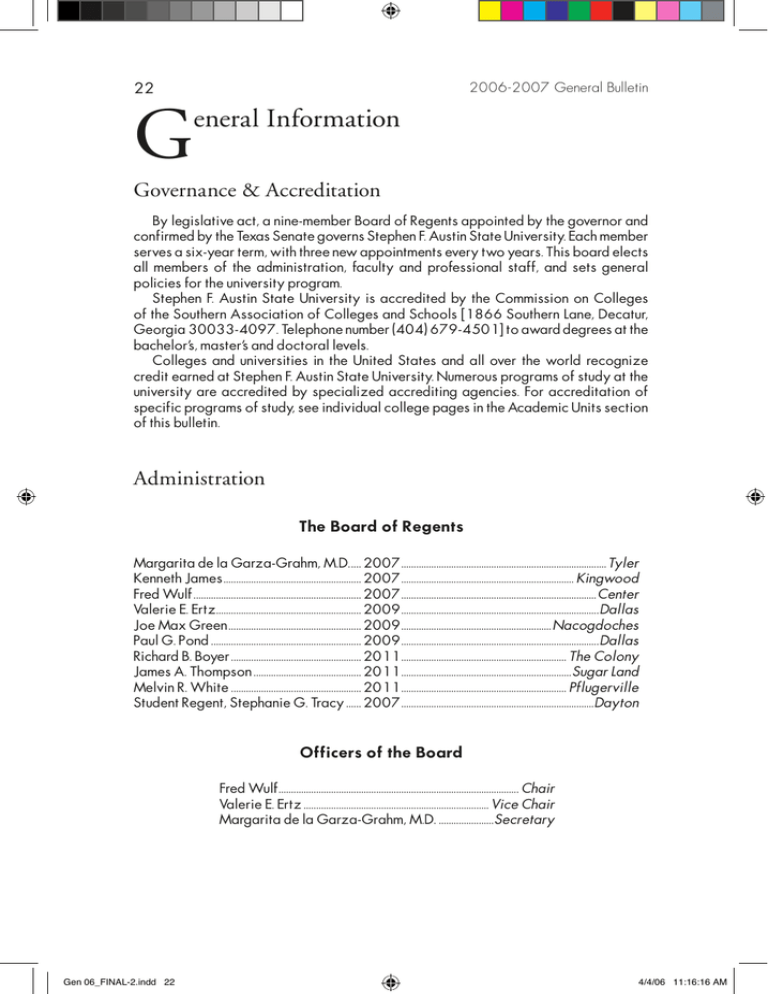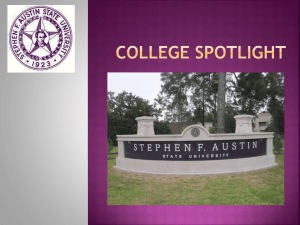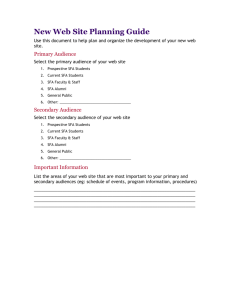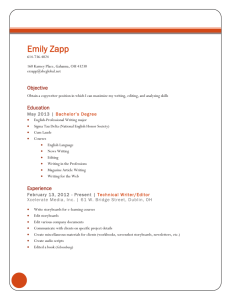G eneral Information Governance & Accreditation 22
advertisement

22 2006-2007 General Bulletin G eneral Information Governance & Accreditation By legislative act, a nine-member Board of Regents appointed by the governor and confirmed by the Texas Senate governs Stephen F. Austin State University. Each member serves a six-year term, with three new appointments every two years. This board elects all members of the administration, faculty and professional staff, and sets general policies for the university program. Stephen F. Austin State University is accredited by the Commission on Colleges of the Southern Association of Colleges and Schools [1866 Southern Lane, Decatur, Georgia 30033-4097. Telephone number (404) 679-4501] to award degrees at the bachelor’s, master’s and doctoral levels. Colleges and universities in the United States and all over the world recognize credit earned at Stephen F. Austin State University. Numerous programs of study at the university are accredited by specialized accrediting agencies. For accreditation of specific programs of study, see individual college pages in the Academic Units section of this bulletin. Administration The Board of Regents Margarita de la Garza-Grahm, M.D. .... 2007 ..................................................................................Tyler Kenneth James ....................................................... 2007 ..................................................................... Kingwood Fred Wulf ................................................................... 2007 ..............................................................................Center Valerie E. Ertz.......................................................... 2009 ...............................................................................Dallas Joe Max Green ..................................................... 2009 ............................................................Nacogdoches Paul G. Pond ............................................................ 2009 ...............................................................................Dallas Richard B. Boyer .................................................... 2011 .................................................................. The Colony James A. Thompson ........................................... 2011 ....................................................................Sugar Land Melvin R. White .................................................... 2011 .................................................................. Pflugerville Student Regent, Stephanie G. Tracy ...... 2007 .............................................................................Dayton Officers of the Board Fred Wulf................................................................................................ Chair Valerie E. Ertz .......................................................................... Vice Chair Margarita de la Garza-Grahm, M.D. ......................Secretary Gen 06_FINAL-2.indd 22 4/4/06 11:16:16 AM 2006-2007 General Bulletin 23 Officers of Administration Tito Guerrero, III, Ed.D. ................................................................................................................................President Mary Cullinan, Ph.D. .................................................Provost/Vice President for Academic Affairs Marlin C. Young, Ed.D. ...................Associate Provost/Vice President for Academic Affairs Deborah S. Baisden, M.B.A.. ..............................Vice President for Finance and Administration Jerry E. Holbert, Ph.D. .................................................. Vice President for University Advancement Baker Pattillo, Ph.D. ........................................................................Vice President for University Affairs David L. Jeffrey, Ed.D. ....... Associate Vice President for Graduate Studies and Research Alumni Association Jim Jeter, M.Ed. .............................................................. Associate Vice President for Alumni Affairs Deans of Colleges James O. Standley, Ph.D. ..............Dean of the College of Applied Arts and Sciences, and the College of Liberal Arts Violet C. Rogers, Ph.D. ...........................................................................Dean of the College of Business John E. Jacobson, Ed.D. .....................................................................Dean of the College of Education Richard Berry, D.M.A. ............................................................................Dean of the College of Fine Arts R. Scott Beasley, Ph.D. .....................................Dean of the College of Forestry and Agriculture Anthony J. Duben, Ph.D. ........................... Dean of the College of Sciences and Mathematics Gen 06_FINAL-2.indd 23 4/4/06 11:16:16 AM 24 2006-2007 General Bulletin University Vision, Mission & Core Values Vision Stephen F. Austin State University will be the national model of a high quality, studentfocused, comprehensive university whose graduates are productive citizens and successful leaders. Mission The mission of Stephen F. Austin State University is to provide students a foundation for success, a passion for learning and a commitment to responsible global citizenship in a community dedicated to teaching, research, creativity and service. Core Values At SFA, we value: The Individual Student: Each student is an important member of the university community and deserves our time and attention. The size of our university, the priority of our teaching mission and the commitment of our employees make such personal attention to students possible. Respect and an assumption of ability and good will are extended to all members of the university community — students, faculty, administrators and staff — by all members of the community. Teaching and Learning: Stephen F. Austin State University is a teaching-centered institution that values learning, intellectual achievement and well-qualified educators who are committed to teaching. Each student is expected to emerge from the university experience as an educated person of integrity, thoroughly knowledgeable in one or more specific fields and capable of analytical reasoning. Intellectual and Creative Discovery: Stephen F. Austin State University places significant value on the development of new knowledge and on cultural enrichment. Therefore, the university is committed to providing faculty, staff and students with opportunities for innovative accomplishments through creative and scholarly activities. Service: Stephen F. Austin State University values its role in serving the educational, cultural, social and economic needs of society. Course and degree offerings reflect regional, national and international needs. Consulting, other professional services and cultural events offered by the university are designed to enrich and improve the greater community. Academic Achievement: Stephen F. Austin State University values academic achievement through students, faculty and staff working diligently and cooperatively. Educational experiences are provided that will empower each student to succeed. The university values knowledge, understanding, wisdom, diligence, integrity, high principles, enthusiasm and responsibility, along with consideration for all peoples of the world. This is the legacy we desire to pass on to the students of Stephen F. Austin State University. Gen 06_FINAL-2.indd 24 4/4/06 11:16:16 AM 2006-2007 General Bulletin 25 Location & History Every history of Texas must include Nacogdoches. For more than two centuries, it was a pawn in French-Spanish imperial rivalries. As the capital of East Texas, Nacogdoches led in the Texas independence movements and was the seat of three republics before the successful Lone Star Republic. The city, therefore, flies nine flags rather than the traditional six flags. The university tradition in Nacogdoches dates back to 1845 when the Republic of Texas chartered Nacogdoches University, which closed in 1904. The movement to replace the Old University succeeded in 1917 when the state of Texas decided to create a teachers’ college “east of the 96th meridian.” Nacogdoches won the prize. On September 18, 1923, the founding president, Alton W. Birdwell, opened the college in temporary quarters. The college moved to the present campus, on the homestead of Texas statesman Thomas J. Rusk, in May 1924. SFA pioneered higher education in East Texas. The first 30 years, while difficult, were years in which the college became a source of regional pride and hope. The state did not fund the Rusk Library Building until 1926 and did not fund any other buildings until after World War II; however, generous donations allowed the college to have a gymnasium and other essential buildings. In the Depression, the East Texas region rallied to support SFA. By the end of Birdwell’s presidency, the academic programs were on a solid foundation and were expanding into graduate offerings. By 1939, SFA was the largest employer in the county. Enrollment, however, plummeted after the outbreak of World War II. Dr. Paul Boynton, named SFA’s second president in 1942, faced problems even more dire than the Depression. During the war, Boynton saved the college by recruiting a Women’s Auxiliary Army Corps training camp; after the war, SFA met the flood of returning veterans by procuring army surplus buildings for temporary housing and classrooms. In 1958, Dr. Ralph W. Steen, a highly respected Texas historian, became the third president of SFA. Dr. Steen’s 18-year presidency was a time of unprecedented change. SFA’s enrollment climbed from 2,017 to 11,293, and the annual operating budget increased twelve fold, as did the value of the physical plant. Steen brought SFA through the civil rights movement and integration, the free speech and anti-war demonstrations of the Vietnam era, the sexual revolution, and the shift of the student body from a rural to an urban majority. He helped to create a climate in which positive change could occur. Because he believed first-rate citizens should have a first-rate education, he added undergraduate, graduate and doctoral programs and, in 1969, changed the status of the college to “Stephen F. Austin State University,” with seven schools and its own Board of Regents. Dr. William R. Johnson, the fourth president of SFA (1976-1990), faced statewide retrenchments in Texas education. Many problems that faced President Johnson also occupied the attention of the national academic community: new demographics, changing tax structures, competition from regional campuses of flagship universities, rapid turnover in faculty positions, new student and societal expectations, new national priorities and changing funding formulas. Subsequent presidents and interim presidents at SFA have all addressed these concerns: Donald Bowen (1990-1991), William J. Brophy (1991-1992), Dan Angel (1992-1999), Roland Smith (1999-2001) and Tito Guerrero (2001 to date). Recognizing the impact that planning could have on the institution’s health, Dr. Angel initiated an endowment drive that raised $37,830,83 in pledges from over 3,500 private donors. Dr. Guerrero, while continuing to secure endowments, has challenged the faculty and staff to meet the future with more effective Gen 06_FINAL-2.indd 25 4/4/06 11:16:16 AM 26 2006-2007 General Bulletin and creative leadership. As Stephen F. Austin State University prepared for its 80th anniversary in 2003, it not only reflected on its rich past but also forged ahead on a strategic plan to make itself a stronger and more vibrant resource for higher education in East Texas. In President Guerrero’s words, “None of our goals will succeed if we are not a university where students can get an excellent education and a superior preparation for lifelong learning, a productive career and civic engagement.” Campus The main campus includes 360 acres, part of the original homestead of Thomas J. Rusk, early Texas patriot and United States senator. In addition, the university maintains a 642-acre agricultural research center for beef, poultry and swine production and an equine center; an 18.7-acre experimental forest in southwestern Nacogdoches County and a 25.3-acre forestry field station on Lake Sam Rayburn. In an impressive setting of pine trees and natural beauty, the university has some 28 major instructional buildings and numerous student housing options representing an investment of approximately $500 million. In 1999 a new Science Research Center was developed on a 15.8-acre tract of land on Highway 259 approximately 5 miles from the main campus to support the growing master’s programs in biotechnology and environmental science. Recent construction includes four new broiler houses operated by the Center for Applied Poultry Studies and Research, an expanded and renovated press box at Homer Bryce Stadium, a new athletic training facility and a new Human Services Building, which opened in spring 2004. Construction recently completed, in progress or being designed totals more than $168 million. Scheduled for completion in 2007 is a $30 million student center renovation and expansion that will feature a three-story atrium, a movie theater, a food court, retail shops and more. A new 402-space parking garage adjacent to the student center opened in August 2005. Lumberjack Lodge, a four-story apartment-style facility that houses approximately 316 students opened in January 2006. A 550-space detached parking garage accommodates students living in the new residential facility. Lumberjack Village, a 610-bed, four-building student housing complex, and a 750space parking garage are scheduled for completion by fall 2006. A student recreation center will open in 2007. It will feature a large cardio-fitness and weight area, indoor elevated walking and jogging track, aerobics and dance rooms, climbing rock, leisure pool and spa, glass-backed racquetball courts, outdoor adventure center, wood-floor basketball courts, outdoor sand volleyball and basketball courts and picnic area. A baseball-softball complex also is planned. By balancing a program of new construction with one of ongoing renovation of older structures, the institution has created an attractive, modern and functional living and learning environment for its students and a center of intellectual and cultural enhancement for its region. Library The Ralph W. Steen Library is the main library at Stephen F. Austin State University and is the university’s primary library and learning resource environment. Steen Library houses almost 1.9 million volumes, subscribes to 47,414 serials (27,263 are unique), and subscribes to 58 databases. The library catalog is available for use on campus and remotely online. Sixty-five percent of the serials collection is available in full-text Gen 06_FINAL-2.indd 26 4/4/06 11:16:17 AM 2006-2007 General Bulletin 27 online. Steen Library encompasses 245,000 gross square feet, is ADA-compliant, and has a wireless network throughout. The library is open 106 hours per week when classes are in session. Steen Library is home to the LINC Lab (Library Information and Networking Center), a 135-seat open-access computer laboratory featuring both PC and Macintosh platforms. A total of 200-plus computers are available within the library for open use. Steen Library is home to the Academic Assistance and Resource Center (AARC), a stateof-the-art tutoring center, which is open to all SFA students free of charge. The library also is home to the East Texas Research Center (ETRC), an archive featuring cultural materials indigenous to East Texas and is a designated Federal and State Document Depository. The library also is responsible for the university’s Web site. The library is a member of TexShare, a Texas State College and University Library Consortium. As a member, the library provides students with free in-house and remote electronic searching of almost 100 databases of full-text articles and more than 27,000 e-books. Students can request a TexShare library card, which gives them borrowing privileges when they visit other Texas state college and university libraries. Campus Computing & Technology Information Technology Services (ITS) is responsible for maintaining the availability, functionality and security of the university’s administrative computer systems, wired and wireless campus network infrastructures, wide-area network communications, private intranet portal, e-mail services, and telephone system. ITS also provides separate computer repair services and help desks for students and for faculty/staff. ITS is not the only department that supports computing and technology at SFA. Additional campuswide services are provided by two other departments, while laboratories and technology centers in the various schools and colleges offer more specialized support. Collectively, these facilities and services provide students, faculty and staff with a technology-rich educational environment. The Office of Instructional Technology (OIT) supports faculty and students in the use of instructional technologies to enhance the teaching and learning process. OIT facilitates the integration of technology into instruction in classroom and distance education environments through professional development workshops, consultation and support services for faculty and students. OIT also provides support for all facets of electronically delivered instruction such as interactive videoconferencing (ITV) and Web-based systems such as WebCT. The Ralph W. Steen Library provides general student academic computing support, manages a major student computing laboratory and provides electronic access to informational resources both within and external to the library collections. The library also manages SFA’s public Web site. SFA provides all students with robust, personalized software tools and a highperformance network. All students receive both an SFA e-mail account and a private account on mySFA, the university’s intranet portal, at the time they are admitted. Students use mySFA to accept financial aid, register for classes, complete class assignments through WebCT, check grades, vote in campus elections, respond to surveys, gain access to campus e-mail accounts, learn about upcoming activities, participate in campus groups, enter chat sessions, create personal calendars, and read world, national and local news. Gen 06_FINAL-2.indd 27 4/4/06 11:16:17 AM 28 2006-2007 General Bulletin All residence halls rooms have high-speed connections to the Internet. SFA also participates in the Internet2 research network, a consortium led by 200-plus universities working in partnership with industry and government to develop and deploy advanced network applications and technologies. In addition, SFA is a founding member of LEARN. The Texas Legislature has charged this higher education consortium with building and operating a statewide fiber backbone that will complete the nationwide next-generation National Lambda Rail (NLR) research network. By holding a seat on the LEARN Board of Directors, the university has taken a leadership role in making the latest networking technology available to the state and researchers at SFA. The university provides free anti-virus software to all students. Through the Barnes & Noble Bookstore at the University Center, popular Microsoft products such as the Office Suite are available at low cost. The SHACK, ITS’ student technical support facility, is the first line of support for all technology-related questions. Services such as removing viruses from students’ workstations are available at no cost. The facility is temporarily located at 119 Feazell St. until a permanent location is built in 2006. Telephone and walk-up service is provided from 10 a.m. to 1 a.m. Monday through Friday. Alumni Association Organized in 1928, the Stephen F. Austin State University Alumni Association is a non-profit organization dedicated to serving the alumni, friends and current students of Stephen F. Austin State University through programs, scholarships and activities that create an attitude of continued loyalty and support. From its on-campus office, the organization sponsors a number of scholarships and awards. It also maintains addresses of ex-students, informs alumni on its activities and information as well as university events by publishing a quarterly magazine and other alumni publications, operates the Charter Chapter program, sponsors the annual Homecoming and conducts the Mentor Ring program. The combined Alumni Association and Alumni Foundation endowments now total nearly $18 million and have provided more than $1 million in scholarships and awards in recent years. In 1966, the association inaugurated the Distinguished Alumnus Award, presented each year at the membership meeting at Homecoming. The Celebration of Excellence honors the recipients of the Distinguished Professor Award and Outstanding Young Alumnus Award. The association also hosts a reception for the 50-year anniversary class each spring graduation. All former students and SFA friends are encouraged to be active in the Alumni Association through one of the following membership plans: Annual, $40; Student Annual, $25; Life, $450; Student Life, $400; Joint Life, $500; Senior Life, $300; or Joint Senior Life, $400. Correspondence regarding membership or activities of the organization may be addressed to SFA Alumni Association, P.O. Box 6096, SFA Station, Nacogdoches, Texas 75962; telephone (936) 468-3407, or through its Web site (www.sfaalumni.com). Student scholarship applications are available beginning Sept. 1 of each year online or at the Tracie D. Pearman Alumni Center. Deadline for applying is Feb. 1 of each year. Gen 06_FINAL-2.indd 28 4/4/06 11:16:17 AM 2006-2007 General Bulletin 29 University Advancement The Office of University Advancement is all about relationships—discovering them, nurturing them, valuing them. As one of the main divisions of Stephen F. Austin State University, University Advancement generates external recognition, support and financial resources essential for the university to carry out its mission and to achieve its goals. Working with alumni, parents, friends and the community, University Advancement broadens the resources available to the university to enhance academic quality and institutional prestige. All of the units of University Advancement work together to bring recognition and resources to the university. The Development Office works closely with faculty, volunteers and donors to help meet key specific funding needs of the various colleges and programs. In addition, University Advancement staffs the university’s generalpurpose philanthropic foundation, the SFASU Foundation, Inc. Public Affairs The Public Affairs Office builds better understanding of the university among the campus community, the media and community leaders. News stories on university activities, faculty, staff and student achievements, and other publicity is generated and disseminated to local, area and statewide media through the Office of Public Affairs. The office also produces promotional and informational publications, maintains a university calendar of events, produces promotional video presentations, provides photography services to the university, and compiles and disseminates a quarterly newsletter to staff and faculty. Gen 06_FINAL-2.indd 29 4/4/06 11:16:17 AM





